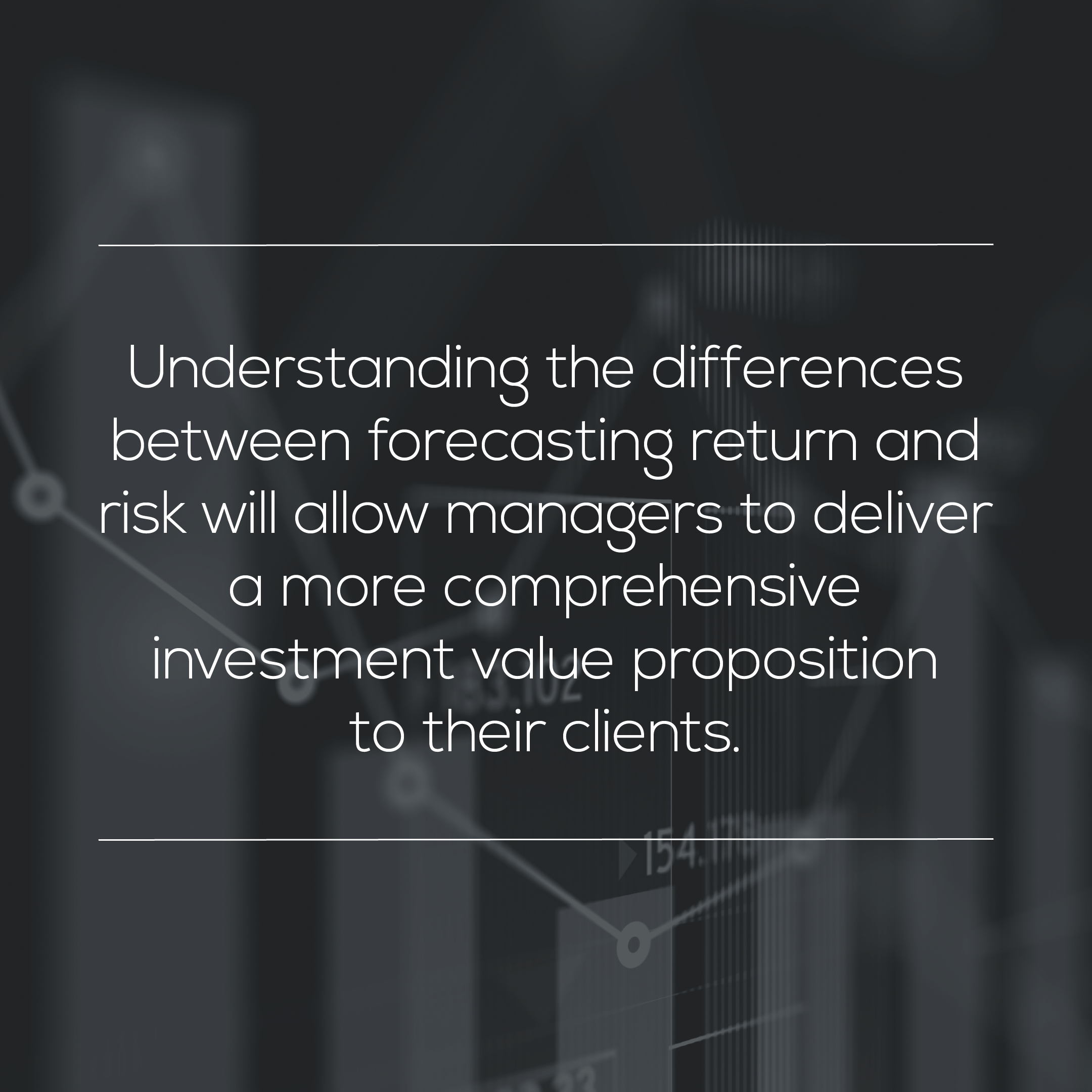It’s common for asset managers to communicate their expected return forecasts to clients, but less so their expected risk forecasts. We believe a key reason for this is that the language of risk and return are different. Return is well-defined by PnL, whereas risk needs to be viewed as an analytical toolbox, with each analytic having a specific use in the risk forecasting problem. Understanding the differences between forecasting return and risk will allow managers to deliver a more comprehensive investment value proposition to their clients.
Approaching the problem
 In a recent blog we proposed risk analytics as a means by which investment managers can drive conversations with their investors in order to better understand their investment preferences and risk tolerances. This allows investment managers to differentiate themselves in an increasingly competitive landscape.
In a recent blog we proposed risk analytics as a means by which investment managers can drive conversations with their investors in order to better understand their investment preferences and risk tolerances. This allows investment managers to differentiate themselves in an increasingly competitive landscape.
So how should an investment manager go about approaching this?
It’s standard practice for investment managers to publish return forecasts. This may take the form of a global asset class outlook, a view on which sectors of the bond market are rich/cheap, or even involve picking individual equities to outperform. These forecasts may be very large absolute return forecasts from hedge fund managers, or more moderate sector or factor tilts implemented by managers with relative return mandates.
However, it is less often that managers publish analytical risk forecasts to complement those for return. We detail why we believe this is the case below. Ultimately we propose that managers consider providing risk forecasts to their investors in the same way which they do return forecasts.
The language of risk and return
The language of return is profit and loss. While there are different ways of presenting PnL, we notably have rules via the Global Investment Performance Standards (GIPS) which define ethical best practices of presentation.
Risk does not have the same kind of definitive language as return.
Markowitz Modern Portfolio Theory (MPT) defined risk as portfolio variance, which is the volatility or variability of portfolio return. This idea allowed MPT to define how portfolio expected return could be maximized for a desired level of risk. MPT also showed investors how owning non-correlated assets could offer a “free lunch” by reducing portfolio volatility while maintaining the same level of expected return. This is of course diversification.
It’s common for investors to have risk presented to them in terms of volatility. This is perhaps coupled with a few first order sensitivity measurements such as beta or duration. Beyond these metrics however, risk often abandons the use of analytics and instead is discussed qualitatively.
We see volatility as a useful, though incomplete, language for risk.
Reasons for this include:
- Investors don’t all view risk in the same way, thus portfolio volatility is not always the most appropriate metric.
- Portfolio volatility itself has notable assumptions underlying it, for example, returns that are normally distributed with each other. Investors are aware that this is not always true, we sometimes see fat-tails in returns.
This is also likely why there is not a broadly accepted GIPS-equivalent standard for risk. There are notable efforts in this area, such as the Open Protocol Enabling Risk Aggregation (OPERA) which provides a standard way in which hedge funds report exposure and risk information to investors. Hedge funds typically have broad mandates to use leverage and derivatives, so efforts to standardize reporting are especially welcome. Similarly, the UCITS and AIFMD regimes in Europe specify risk reporting standards for investment managers.
The language of risk is closer to a framework, or a toolbox, in which volatility-based risk analytics are one element. To create analytic risk forecasts for clients we encourage managers to understand the strengths and weaknesses of all of the tools in this analytical toolbox and then marry them with the risk needs of their investors.
Implementing risk forecasts for clients
StatPro Revolution provides an analytics toolbox which can be used to create risk forecasts for clients. Revolution also offers the ability to easily configure and distribute these forecasts via analytics dashboards tailored to the individual client or group.
For example, consider an investor with a long time horizon. They may care less about the volatility of the portfolio and more about decomposing the portfolio to ensure core sources of risk are aligned with their return forecasts. In this case a risk forecast could be built with an emphasis on risk decomposition. This could encompass equity-style factor decomposition (value, momentum, volatility, etc), core risk driver decomposition (rate, spread, FX, equity prices, equity volatility, inflation, etc.), or even assessing aggregate beta sensitivities to market indices like the S&P500 or MSCI EM.
Contrast this with an investor whose primary concern is near-term principal protection. They will likely be more concerned with understanding what contributes to this volatility and how it may change in the future. A risk forecast here could monitor marginal risk contributions to portfolio volatility and correlations over time. This would allow the portfolio to be brought back into line should volatilities or correlations shift. A risk forecast could also assess a range of portfolio stress tests and scenarios to establish worst-case loss events. This could be used to hedge the portfolio against stress events where losses move outside of acceptable tolerances.
It’s difficult to make accurate return forecasts, especially in the short term. Risk on the other hand is all about using analytics to make forecasts. Managers should take advantage of this. We believe that correctly implemented, the ability for managers to offer risk forecasts to their clients can be a powerful differentiator.
{{cta(’08b59f3e-3079-4d0f-b99a-ccb854f074e8′)}}